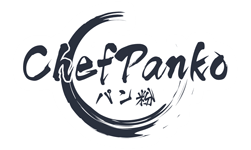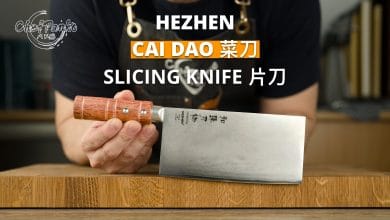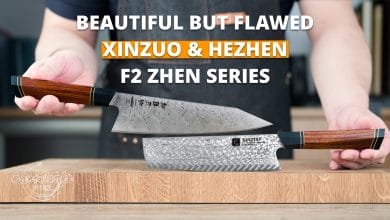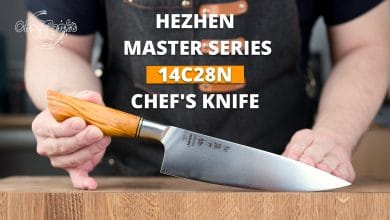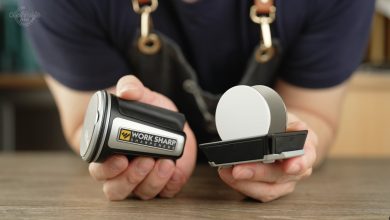The knife comes with 16 layers of stainless steel holding the VG10 core, giving it a layered hazy pattern. While the layers add to the aesthetic of the 24cm Kasumi Yanagiba it also strengthens the VG10 core.

The version I’m reviewing here is the Kasumi VG10 series they also have a Kasumi Pro series and other series with various specifications and core material.

The Kasumi VG10 non-pro line comes with a Rockwell of 59 to 60. The knife thickness is 3mm in the neck area and 2.7mm in the middle indicating that the knife has a distal taper.
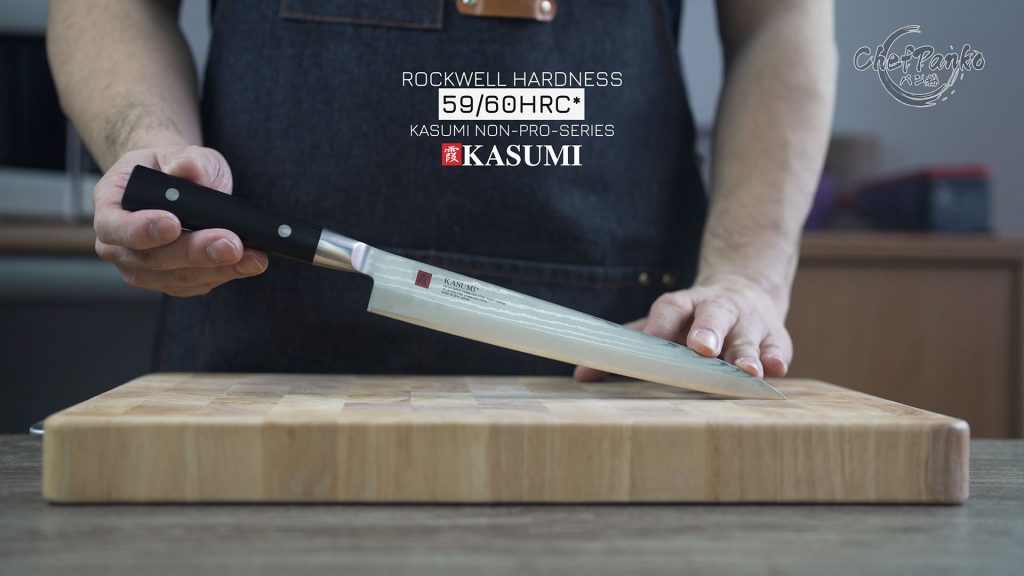
Knife Handle & Comfort
The Kasumi handle has a full tang half bolstered handle with 2 rivets.
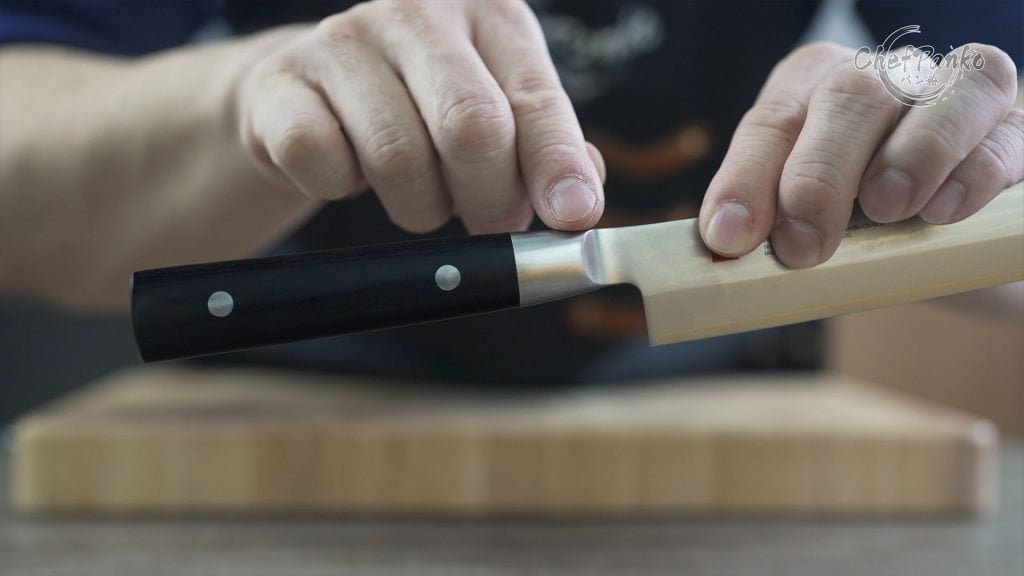
You will notice that the full tang handle is inserted into a pakkawood handle. The handle is surprisingly comfortable on your hands, due to the rounded contours. In terms of comfort and feel of the Kasumi handle, you can compare it to an octagonal handle without the edges, and in my opinion even more comfortable to hold than an octagonal handle.
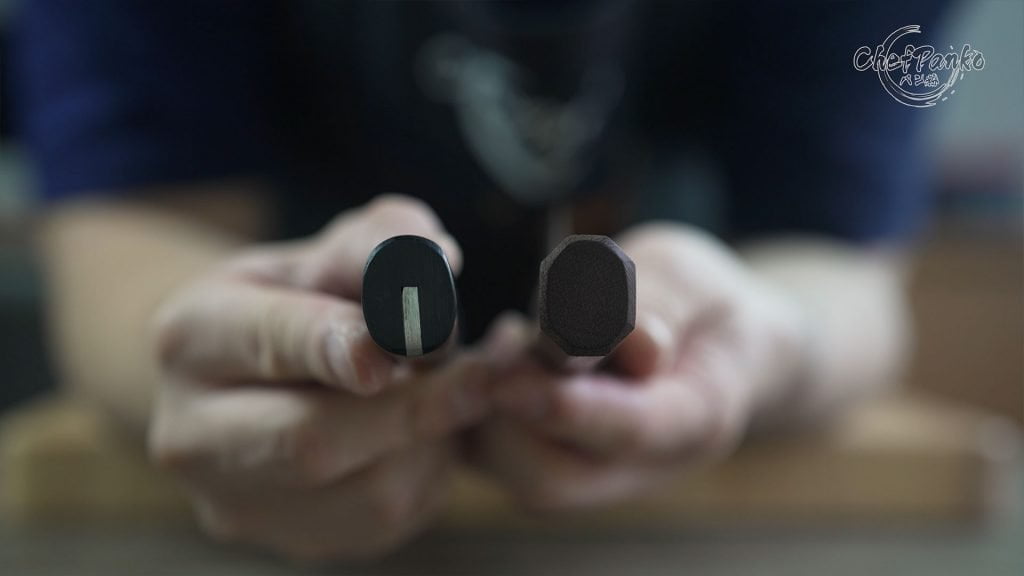
Knife Style & Profile
The Kasumi knife style is a Yanagiba, which is designed and suitable for cutting raw fish fillets into thin slices. With a Yanagiba you will notice that the other side is quite flat and, has a very small concave which is in some cases only noticeable when you start resharpening your knife completely flat on the concave side.

The knife profile is what you would expect from a Yanagiba a nice gentle curve for when you are slicing.
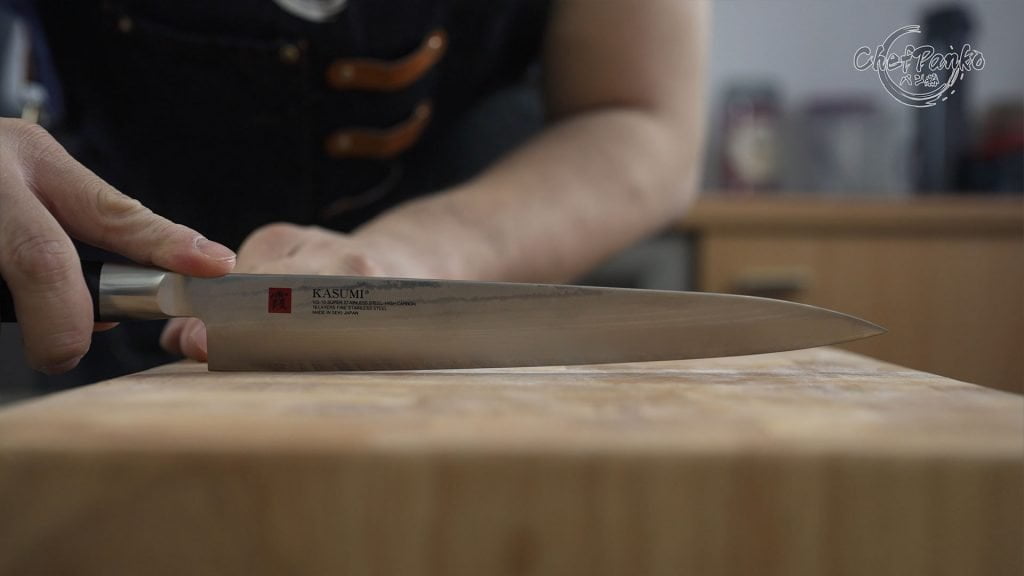
Recommended Gripping Style & Balance Point
What you will notice with all Yanagiba’s is that the knife is very narrow, therefore the gripping style is very limited. As you may have seen is that the majority of sushi chefs use a fingertip grip, this is also forming a habit that they will use this grip on other knife styles too.

For a Yanagiba I recommend the fingertip grip, where your thumb and middle finger determine the balance point, making the Kasumi Yanagiba front-heavy. Which is what you want for a Yanagiba. The point of balance is in front of the red squared kanji. Making all other gripping styles that are in front of the red squared Kanji front heavy.

Core Material & Rockwell Hardness
The Kasumi Yanagiba has a VG10 core which has great stainless properties and holds a decent edge. You don’t have to worry about rusting. The Rockwell Hardness of this knife is 59 to 60. The Rockwell hardness is on the softer side for a Yanagiba with a VG10 core, but Kasumi did something very interesting.
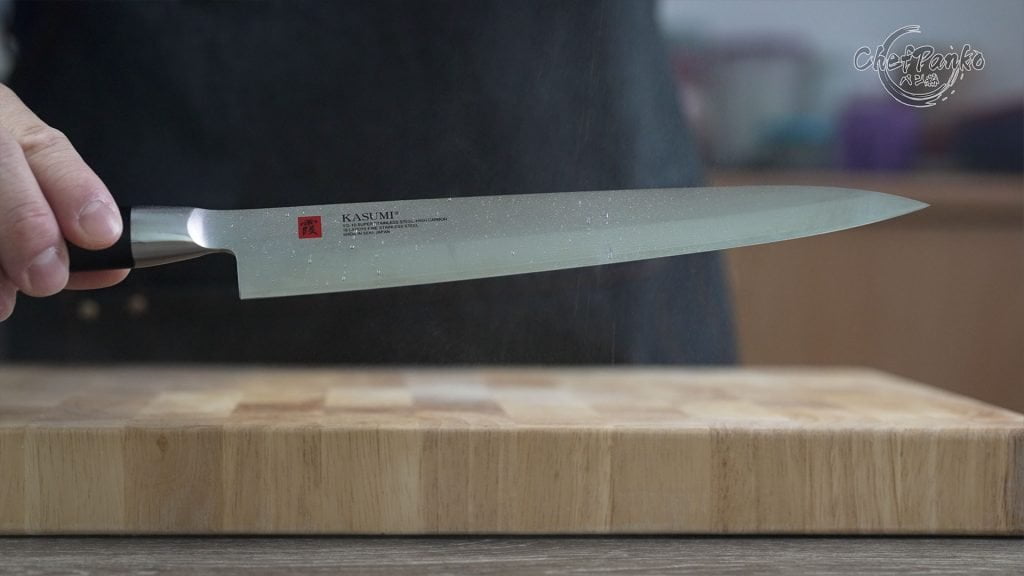
Sharpness & Edge Retention
The concave side is sharpened at around 2 degrees angle which is most likely done to remove the burr from the edge.
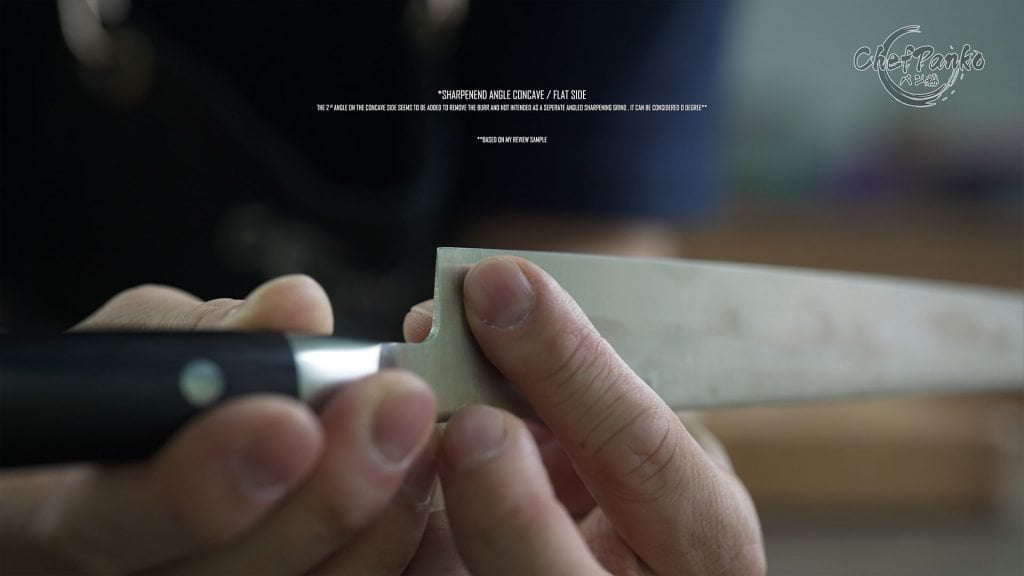
The other side is sharpened at around a 14-degree angle. This will not give you the sharpest performance out of the box but it does get the job done.
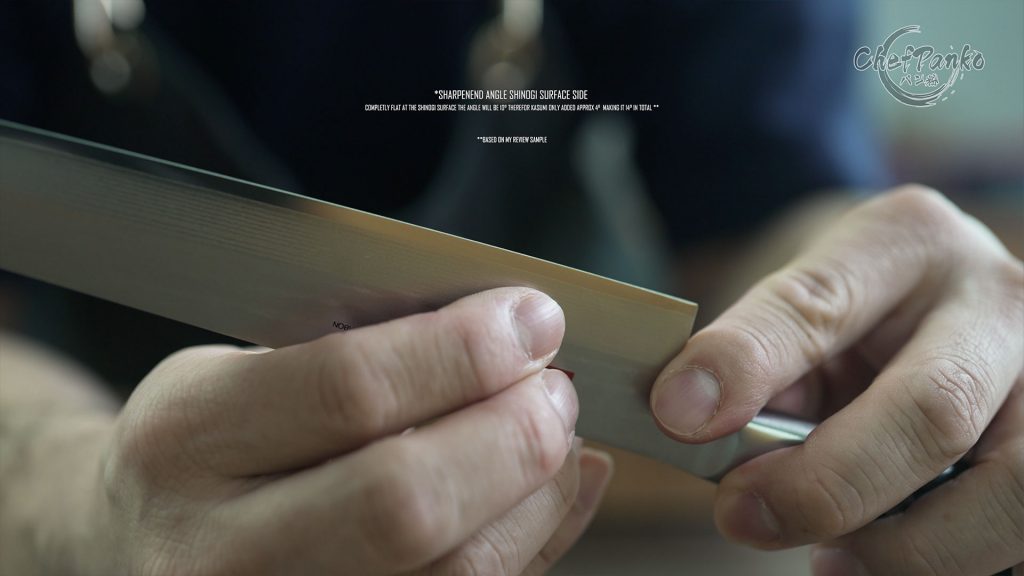
They have increased the out-of-the-box edge retention by doing this, and therefore you will not directly notice the lower Rockwell of 59 to 60, compared to other Yanagiba’s with a Rockwell of 61 with VG10 steel. An interesting choice by Kasumi, since they sacrifice the sharpness for more edge retention and edge durability.
Note: The 2 degrees angle on the concave side seems to be added to remove the burr and is not intended as a separate angled sharpening grind, it can be considered 0 degrees.
Key Takeaway
The Yanagiba from Kasumi is nicely made with some interesting tweaks to preserve edge retention and edge durability. However, due to the tweaks, they are sacrificing sharpness. Therefore it is less sharp especially if you are going to use the Yanagiba to shave off some dark flesh from a salmon fillet. It gets the job done, but you will notice the higher angle and therefore the shaving effect feels less sharp and smooth.

The handle is the biggest surprise and I like the comfort and feel of the handle. This particular handle design will be great for small to large hand sizes. Unless you have an extra-large hand size then this handle may not be a great fit for you.

My Recommendation
If you are a home cook you have to ask yourself if you need a Yanagiba. Since a Yanagiba is designed to slice thin raw fish fillets. And therefore not ideal for hard and dense food or other tasks. Due to the design, it will push you to the flat side resulting in a crooked cut and the thick blade design will also tear denser food instead of a clean cut.

If used in a sushi restaurant, the knife will do decent for slicing sashimi and nigiri, however, shaving the dark flesh from a salmon fillet is not great, since they went for durability over sharpness. The Rockwell hardness is also not ideal if you have to slice through a lot of fish during your prep work at the restaurant.
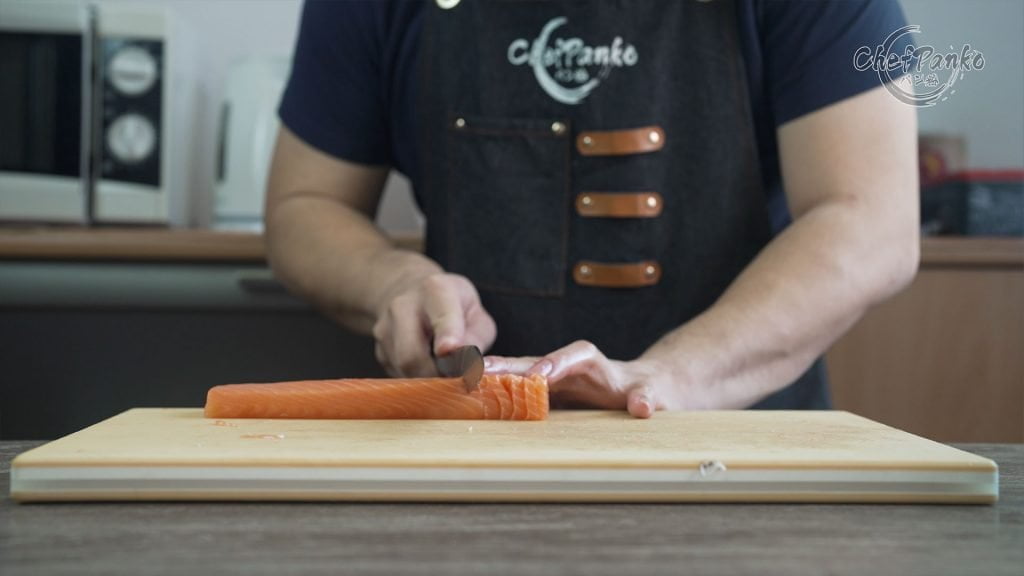
Due to the tweaks that Kasumi made on their Yanagiba, the knife is ideal to slice through sushi rolls or pre-cleaned fillets. Especially with the western take on Sushi with fried shrimp or fried chicken in the sushi rolls. Because of the great edge durability, this Yanagiba is ideal for beginners since the edge is not as fragile compared to higher Rockwell Yanagiba’s. But if you are more experienced you will notice the lesser sharpness, especially during the dark flesh removal process on your salmon fillet.

Maintenance
Due to the higher sharpened factory angle and the lower Rockwell hardness of this Yanagiba. I recommend that you keep the factory angle when you are going to resharpen this knife. This also means that I don’t recommend a flat grind on the Kasumi VG10 Yanagiba. If you plan to do a complete flat grind you will notice that the edge retention will decrease a lot faster than the out-of-the-box factory grind. Therefore I like the added 2 degrees just to remove the burr.

To keep the angle as consistent as possible and to preserve the concave, I don’t recommend a honing rod on a Yanagiba.

Note: I bought this 24cm Kasumi Yanagiba in Asia for approximately $1350HKD ( Approx – $170, €150). The prices at the western retailers are significantly higher so keep that in mind before ordering.
🛒S H O P:
NA: Kasumi Cutlery
EU: Kasumi Cutlery
▶ If you want to know what knife you should buy you can read the following article ''Choosing your knife''. ▶ On my youtube channel, I have reviewed a lot of different knives. You can watch the playlist by clicking here. ▶ Click here, if you want to search for other kitchen knives on: Amazon. ▶ , if you want to search for other Chinese knives on . ▶ Check out my gear on Kit: https://kit.co/ChefPanko ▶ Check out my recommendation on Amazon: https://www.amazon.com/shop/chefpanko Full Disclosure: If you purchase from these links I get a small commission that goes towards supporting the channel and website. As an Amazon Associate, I earn from qualifying purchases ▶ If you have any questions about Japanese knives made in China or about some of the brands feel free to ask it in the comment section below. Thank you for your support and feedback. ▶ Want to work with me? Please use the contact form by clicking here.
